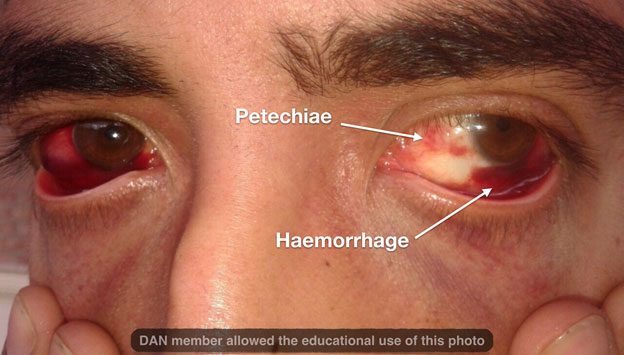Overview
Mask squeeze (mask barotrauma or facial barotrauma) results from a failure to equalize the air space created between your mask and face. In most cases this is a relatively benign injury. It tends to be more common in new divers. Blockages of nose — such as congestion or nose clips — will interfere with mask equalization.
Mechanisms of Injury
As with your sinuses and ears, you must also equalize the air space in your mask as you descend. Failure to equalize by adding air to the space in the mask (by exhaling through your nose), can create unequal pressure between the air space in the mask and the vascular pressure within the blood vessels of the face. The pressure difference can result in various degrees of facial barotrauma, which is an injury to the soft tissues of the face contained within the mask. Imagine your face in a suction cup.
Manifestations
You will likely feel a suction effect over the affected area. The negative pressure over the soft tissues beneath the mask (upper cheeks, nose, lower forehead, eyelids and eyeballs) will cause engorgement of the blood vessels. The result ranges from mild discomfort to pain. After it is resolved by properly equalizing the mask or ascending to the surface, you may show some swelling in the affected area and red, brown, or purple spots (petechiae), particularly on your eyelids.
In some cases, subconjunctival petechiae or hemorrhage (blood from burst vessels) appears in the white of the eye. Visual disturbances are rare, but they are a sign of a more severe compromise and require immediate medical evaluation.

During the healing process, blood will change color from the initial bright red to a darker red, then greenish, then yellowish before the eye returns to its standard white color. This healing is a natural process that corresponds with how your body metabolizes the blood.
Treatment
Unless you are experiencing eye pain or visual problems, there is no treatment for facial barotrauma except time. Because it is essentially a bruise, your body will eventually reabsorb the blood.
If you have eye pain or visual disturbances such as blurred vision or loss of part of the visual field, or feel blood that has accumulated/layered (hyphema) in colored part of your eye (iris), see your physician or an eye specialist immediately. These symptoms are infrequent in mask squeeze. With routine healing, and depending on the extent of the injury, the symptoms of mask squeeze can take up to two weeks or more to resolve. You will probably look worse than you’d like before it gets better. Your body needs to reabsorb the blood and fluid. These are gravity-dependent, meaning they will spread downward on your face.
Who Gets Mask Squeeze?
It is most common in new divers. They tend to be overwhelmed by all the skills they need to remember, such as buoyancy control and equalization of their ears and sinuses, while adjusting to an unfamiliar environment. Experienced divers are not immune to mask squeeze. They tend to get it when they are concentrating on a new activity or focusing on a task that diverts their attention from clearing their mask. Changing to a new mask or a low-volume mask may also lead to mask squeeze because the diver may not be accustomed to when to add air. Poor-fitting masks or other factors, such as facial hair, may lead to problems with equalizing.
Prevention
The solution to preventing mask squeeze is to remember to keep your nasal passageways open during descent by blowing small amounts of air through your nose every time you equalize your ears. By exhaling through your nose and using a properly fitted mask, you will minimize the risk of facial barotrauma. A mask should fit comfortably against your face. You should be able to achieve an appropriate seal by gently placing the mask on your face and inhaling through your nose.
The mask should seal to your face and not fall off even without the mask strap in place. It is not unusual for a small amount of leakage to occur while diving, especially if you have facial hair. Exhaling through your nose and tilting your face towards the surface while cracking the lower seal of the mask will generally remove any unwanted water from your mask. This technique will also keep the air space between the mask and your face adequately
Implications in Diving
For the Diver
- Call the DAN hotline for recommendations if you think you suffered a mask squeeze.
- You can consider a return to diving if a physician determines that the risk of further injury is minimal and manageable.
For the Dive Operator
- Call the DAN hotline for recommendations. As the expedition’s leader, you have a duty of care if they got injured during your trip.
- Offer the diver evaluation by a medical professional.
- Don’t worry about referring them to a doctor with dive medicine experience. Any doctor should be able to help.
For the Physician
- Provide symptomatic treatment.
- Assess for vision deficiencies.
- Assess ears and vestibular function. Mask squeeze injuries could also present with ear or sinus barotraumas.
- Vertigo, nystagmus or hearing loss might be suggestive of inner-ear barotrauma. If present, discourage your patient from further diving until cleared by a specialist.
- Consider recommending no further diving until swelling and inflammation have resolved, and the diver understands and shows competency on how to properly equalize air spaces (ears, sinuses, and mask).
Fitness to Dive
Do not dive until recommended by your physician. Assess why the problem occurred and address each factor. Consider contacting a dive instructor to address preventing future injuries.